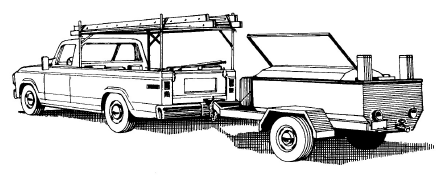The bitumen kettle is loaded either manually by feeding the cold bituminous material through the kettle lid opening or by the gravity feed of hot material from a bitumen tanker. The kettle is typically fired by one or more propane burners with typical heating capacities of 500,000 BTU’s or more. The firing rate of the propane fuel is controlled by a pressure regulator.
The hot bituminous material is withdrawn from the kettle either by mechanically pumping it directly to the roof or by gravity flow into a carrying container. The pump in the kettle, which forces the hot bitumen to the roof, is usually powered by a small diesel or gasoline engine. Kettle models with a pump are typically fitted with a valve mechanism which re- circulates the bitumen within the kettle to reduce localized overheating of the bitumen.
When buckets are used, they should be heavy-duty models capable of withstanding rough use and the substantial weight of the materials involved.
Kettle operator
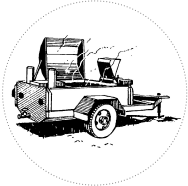 A kettle operator is responsible for assuring safe operation in their immediate vicinity as well as protection of property, equipment and other workers. There are many types of roofing kettles on the market today: under-fired, tube-fired and tankers in large and small sizes using kerosene or propane as the fuel. Each manufacturer has prepared safety precautions that are required in connection with their manufactured product.
A kettle operator is responsible for assuring safe operation in their immediate vicinity as well as protection of property, equipment and other workers. There are many types of roofing kettles on the market today: under-fired, tube-fired and tankers in large and small sizes using kerosene or propane as the fuel. Each manufacturer has prepared safety precautions that are required in connection with their manufactured product.
It is the kettle operator’s responsibility to ensure that they have studied the manufacturer’s operating instructions. A qualified kettle operator will be thoroughly familiar with not only the manufacturer’s literature, but also with heating bitumen, heating equipment in general, the safe use of propane and other fuels, and fire safety and containment. The individual operating the kettle is one of the most important members of the roofing crew. If the crew has to wait for bitumen to be at the proper temperature, work will be delayed. If the bitumen is damaged by overheating, it will no longer be suitable for use in the construction of the roof membrane and will have to be discarded. Severe bitumen overheating can result in kettle fires with associated damage to equipment, property and/or the potential for injury.
Kettle Start-up
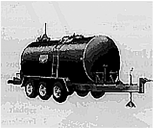 Bitumen kettles should be set on smooth level ground in an area clear of flammable debris or materials and as close as possible to the point of application. A fully charged fire extinguisher of at least 20 lb ABC rating should always be near. Do not place the extinguisher directly on the kettle such that in an emergency the kettle operator will be able to safely reach the extinguisher without getting too close to the kettle itself. Before lighting the burner, the vat of the kettle should be checked for any moisture as moisture in hot bitumen can cause foaming or bubbling which can result in overflow and/or splattering of scalding material.
Bitumen kettles should be set on smooth level ground in an area clear of flammable debris or materials and as close as possible to the point of application. A fully charged fire extinguisher of at least 20 lb ABC rating should always be near. Do not place the extinguisher directly on the kettle such that in an emergency the kettle operator will be able to safely reach the extinguisher without getting too close to the kettle itself. Before lighting the burner, the vat of the kettle should be checked for any moisture as moisture in hot bitumen can cause foaming or bubbling which can result in overflow and/or splattering of scalding material.
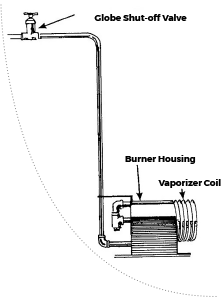 Propane burners are always controlled by using the regulator valve rather than the shut-off valve.
Propane burners are always controlled by using the regulator valve rather than the shut-off valve.
One of the greatest safety problems with kettle firing lies in the use of oversized burners, which must be throttled back when the operating temperature is reached. This is not recommended because throttling may be necessary to such an extent that poor burner control and uneven firing will result. Oversized burners can also cause localized overheating of the heating tubes which can create a hotspot that reaches the auto-ignition temperature of the bitumen and cause a fire or explosion.
Face shields should always be worn when lighting or adjusting a burner, loading the kettle, or handling the heated bitumen. Extreme care must be taken so that no one is in direct line of fire. The burner should be lit outside the burner well, and then placed in position in the heating tube. Once a burner has been lit, the kettle operator must stay with it at all times in order to make any required adjustments. This is particularly important when heating a cold kettle at the beginning of a shift.
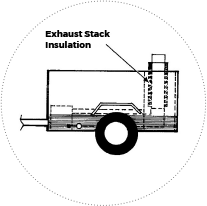 Kettles should be brought up to the desired operation temperature slowly. Otherwise, excessively high surface temperatures could be created in the front part of the heating tube and in the position of the exhaust stack inside the vat, both of which could cause auto-ignition and/or an explosion. To prevent excessively high temperatures in the heating tubes, they must also be covered by the bitumen at all times. If this is not possible, the kettle burner should be turned down to an extremely low level until new bitumen is added or, in the case of cold asphalt cake or chunks of coal tar pitch, until the new material has had a chance to melt and completely cover the heating tube.
Kettles should be brought up to the desired operation temperature slowly. Otherwise, excessively high surface temperatures could be created in the front part of the heating tube and in the position of the exhaust stack inside the vat, both of which could cause auto-ignition and/or an explosion. To prevent excessively high temperatures in the heating tubes, they must also be covered by the bitumen at all times. If this is not possible, the kettle burner should be turned down to an extremely low level until new bitumen is added or, in the case of cold asphalt cake or chunks of coal tar pitch, until the new material has had a chance to melt and completely cover the heating tube.
Tests have also shown that surface temperatures of the portion of the exhaust stack that is inside the vat and always exposed above the bitumen can be in excess of 527°C (980°F) when operating some burners as low as 48.3 kPa (7 psi). The possibility of this portion of the stack causing auto-ignition or an explosion can be greatly reduced by installing an insulation jacket protected with a metal sleeve around the stack.
Whenever operating a kettle make sure that:
- The covers on kettles are constructed to lock tightly, and shall have vents providing a total open area of not less than 32 cm² (5 in2).
- Kettles are equipped with adjustable supports for use in setting kettles so that they are level.
- The fuel tank of every kettle that depends upon the pressure for fuel delivery shall be equipped with a spring-loaded relief valve set to pop at a pressure not to exceed the maximum safe working pressure of the vessel.
- A dry chemical or other approved fire extinguisher rated at least 20 ABC shall be avail-able to the kettle operator at all times that the kettle burner(s) are operating.
- An extension handle of sufficient length to permit safe closing of a stuck spigot shall be attached to the kettle at all times.
Kettle Loading
The kettle operator should wear the proper protective clothing and equipment and avoid working directly over the open kettle top when adding cold bitumen to the kettle. The cold bitumen should be cut or broken into small chunks and added a little at a time to minimize the possibility of splashing the hot contents of the kettle. The kettle should never be loaded too full with new cold material because bitumen expands when heated and may overflow.
The practice of manually stirring the hot bitumen should be avoided. Most of the newer kettles are equipped with a pump that recirculates the heated bitumen. If the bitumen must be stirred, as is the case with older units, a solid piece of wood of sufficient length should be used. A hollow pipe or similar implement should never be used because moisture in the pipe can cause the hot bitumen to blow up through the pipe and result in serious burns.
Drawing Off the Bitumen
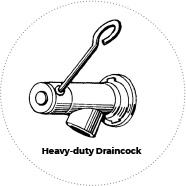 Drawing off the hot bitumen from the kettle can be very hazardous and no attempt should be made to draw off material until all of the bitumen in the vat is melted and has reached the proper temperature. Attempting to draw off the material before it is fully melted will usually plug the draw-off valve. When trying to unplug it, the flow will suddenly start again and burn the operator’s hands and arms. All draw-off valves should be equipped with an extension lever so that the operator will be at a safe distance from the draincock in the event of a spill. Drawing off should cease once the level of the hot bitumen in the kettle exposes the heating tube. New material should be added at this time to avoid overheating the exposed surface.
Drawing off the hot bitumen from the kettle can be very hazardous and no attempt should be made to draw off material until all of the bitumen in the vat is melted and has reached the proper temperature. Attempting to draw off the material before it is fully melted will usually plug the draw-off valve. When trying to unplug it, the flow will suddenly start again and burn the operator’s hands and arms. All draw-off valves should be equipped with an extension lever so that the operator will be at a safe distance from the draincock in the event of a spill. Drawing off should cease once the level of the hot bitumen in the kettle exposes the heating tube. New material should be added at this time to avoid overheating the exposed surface.
Automatic Temperature Control
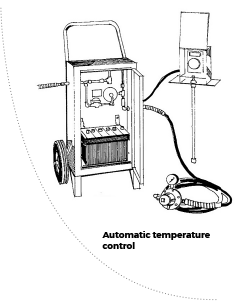 Some modern bitumen kettles are regulated by an automatic temperature controller. It is important that the temperature controller function properly. If the kettle operator has any doubt about the performance of this device, the kettle should be shut down, the device checked and if necessary, repaired or replaced by a competent pers If the kettle does not have an automatic controller, temperature must be controlled manually with the help of the kettle thermometer.
Some modern bitumen kettles are regulated by an automatic temperature controller. It is important that the temperature controller function properly. If the kettle operator has any doubt about the performance of this device, the kettle should be shut down, the device checked and if necessary, repaired or replaced by a competent pers If the kettle does not have an automatic controller, temperature must be controlled manually with the help of the kettle thermometer.
Thermometers
The temperature of the bitumen in the kettle is usually determined by means of a small dial thermometer mounted on either the side of the kettle or at the end of the kettle opposite the burner.
Many experienced kettle operators do not rely on thermometer readings but depend mainly on the workability of the molten bitumen. This practice is dangerous because in recent years the flashpoint of asphalt used in roofing has been lowered. This means that the working temperature and the flashpoint are much closer together, and that the firing of the kettle must be more finely controlled so that the temperature of the bitumen never reaches the flashpoint. The degree of control required means that a reliable thermometer must be used. Failure to use accurate control can result in overheating which deteriorates the quality of the asphalt and, when the flashpoint is reached, causes a fire.
Precautions for Kettle Operation
Asphalt temperatures in kettles should be maintained consistent with the proper workability for roofing application (equiviscous temperature). It is recommended that bitumen be heated to no higher than 14°C/25°F below its minimum flashpoint temperature.
Avoid overheating the kettle to reduce the likelihood of a kettle fire or explosion.
Reduce worker’s exposure to asphalt fumes. By reducing temperatures by 28°C/50°F, a worker’s exposure to fumes can be cut in half.
Thermometers should always be used as a guide to operation. Spitting into the bitumen, should never be employed to determine proper kettle temperature.
Thermometers should be checked and calibrated regularly and replaced when found inaccurate or defective.
Kettle temperatures should be checked frequently. The amount of heat required to maintain the temperature at a constant level will decrease as the material is drawn off. Where possible, the temperature should be taken at more than one location with a dip thermometer.
Bitumen Pump & Packing Gland
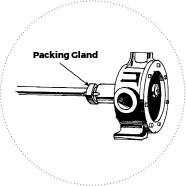 Kettle pumps should be lubricated regularly with a reliable high- temperature lubricant.
Kettle pumps should be lubricated regularly with a reliable high- temperature lubricant.
Pump packing should be checked and adjusted on a regular basis to keep leakage to a minimum. The packing should also be replaced when adjustment fails to reduce leakage.
The following rules for kettle safety must be followed:
- Wear shirts and gloves when working around the kettle. Wear face shields to protect eyes from splashes, as most kettles are at face level.
- Once the kettle is lit, it should not be left unattended.
- Keep a clear path between the kettle and the hoist line. This is the first move to prevent stumbling.
- Clear away all rubbish around the kettle to prevent stumbling and to reduce fire hazard. A clean working area also reflects good working habits.
- Keep the interior of kettle cleaned of debris and residue of overheated bitumen. A kettle that is dirty on the inside will perform poorly and will be more prone to bitumen ignition.
- Remove excess bitumen from the exterior of the kettle. Bitumen on the kettle exterior will burn.
- Place chunks of asphalt or pitch carefully into the kettle in order to prevent splashing.
Pumping Bitumen
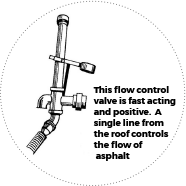 Many kettles are equipped with a pumping system to deliver hot bitumen to the roof. A single line from the roof to the delivery valve on the kettle controls the flow. The pipes of these systems should always be insulated or guarded to prevent burns from accidental contact. Before pumping bitumen, the pipeline should be checked to ensure that it is properly installed and adequate for the application. All pipes and fittings should be clear of obstructions. The pipeline should be supported where necessary to avoid strain and excessive deflection. The outlet should be securely fastened to the roof to prevent movement and thoroughly inspected to ensure that it is clean and operating properly.
Many kettles are equipped with a pumping system to deliver hot bitumen to the roof. A single line from the roof to the delivery valve on the kettle controls the flow. The pipes of these systems should always be insulated or guarded to prevent burns from accidental contact. Before pumping bitumen, the pipeline should be checked to ensure that it is properly installed and adequate for the application. All pipes and fittings should be clear of obstructions. The pipeline should be supported where necessary to avoid strain and excessive deflection. The outlet should be securely fastened to the roof to prevent movement and thoroughly inspected to ensure that it is clean and operating properly.
Where the pipe is discharging within 2 m (6 ½ ft) of the edge of the roof, a guardrail must be installed. This flow control valve is fast acting and positive. A single line from the roof controls the flow of asphalt.

Kettle Towing
Bitumen kettles must be towed in accordance with Occupational Health and Safety Acts, Regulations for Construction Projects and Highway Traffic Acts. Failure to comply is not only dangerous, it will result in the immediate removal of the vehicle from the road and/or a substantial fine. Remember the following:
- Kettles must be equipped with turn indicators and brake lights.
- A suitable safety chain must be secured to the kettle in addition to a tow hitch. Check the tow hitch and the safety chain before hooking up the kettle.
- After hooking up, check again to be certain that both the tow hitch and the safety chain are secure and cannot shake loose in transit.
- Connect the lights and ensure that they are operating properly and are clearly visible.
- If the kettle is equipped with brakes, be sure that they are connected and working properly.
- Let the bitumen cool before transporting.
- If it is necessary to transport hot bitumen, be sure that the level in the kettle is low enough to prevent spillage when starting, stopping and cornering.
- Drive carefully. Avoid fast starts, sudden stops and sharp cornering.
- Use only proper highway tires. Check the tire pressure regularly.
- Grease all wheel bearings regularly.
- Do not operate burners when the kettle is being towed.
- Make sure that loose tools or materials are not left on the kettle.
- Always carry a fully charged fire extinguisher and complete first-aid kit in the truck when towing a bitumen kettle.
